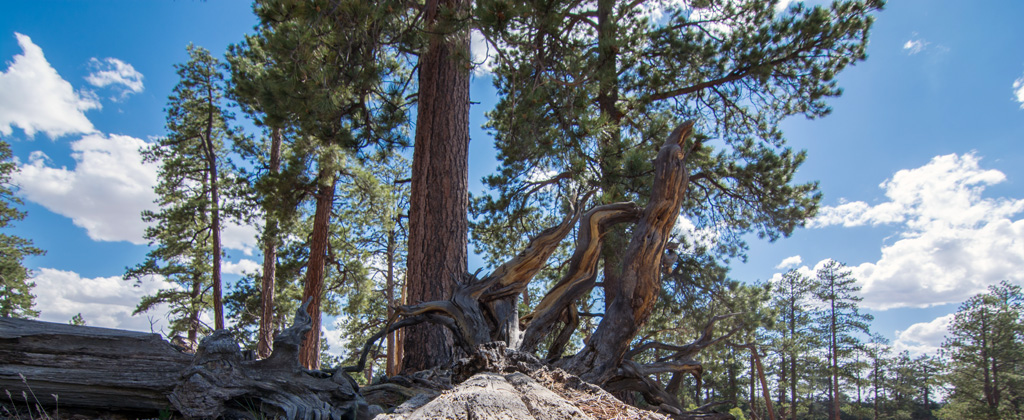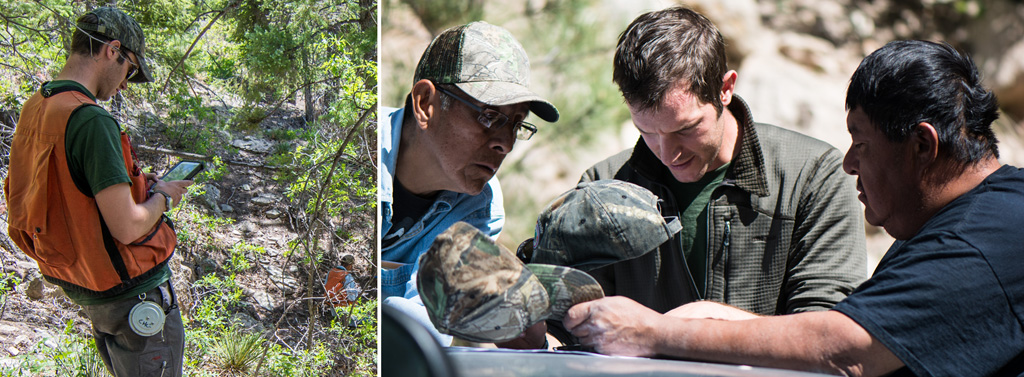Notes from the Field: Dendrochronology, Wildfire, and Iron Maiden
 Chuska Mountains, Navajo Nation - Photo by Dan Ferguson
Chuska Mountains, Navajo Nation - Photo by Dan Ferguson
Just how old are the forests in the Chuska Mountains in the northeastern part of the Navajo Nation? How might those forests fare in a climate that will be warmer and probably drier than anything they've ever experienced? In early June I had the chance to tromp around in the woods with a group of experts working to answer these questions. Our intrepid leader was UA Laboratory of Tree Ring Research PhD student Chris Guiterman who—I now know—is a man with a plan. The plan goes something like this:
Step 1: Build a mutually beneficial partnership with the Navajo Nation Forestry Department. Judging by the warm reception he received from the Navajo foresters when we showed up for a week of fieldwork, I'm going to call this one done. Chris managed to build a great relationship with the foresters over the last year or so without knowing exactly where the money would come from to do the research. During that time he developed a set of research questions that—when the project is done—will help the Navajo Nation manage their forests and also help all of us better understand how individual forests have responded to previous climate conditions. The hope is that through this project Chris and his colleagues will give us some clues about how these forests may deal with what we expect to be tough 21st century conditions.
Step 2: Find resources to carry out the research. Here's where CLIMAS enters the picture. Chris is one of four outstanding UA graduate students to receive support through our new Climate and Society Fellows program. As it happens, we're not the only group who thinks Chris is on to something good. He recently learned that he'll also be a recipient of a prestigious EPA Star Fellowship to carry out this research. And last but not least, he's attracted the attention of one other funder who may pony up enough money to allow Chris to put together his dream team of UA researchers and Navajo foresters.
Step 3: Do science. I showed up for the very first part of this step, which began the week of June 9. I'm no dendrochronologist, but it was thoroughly enjoyable playing one for a week. Except the 50mph winds. And the dust. And the damned caterpillars falling out of aspen trees. Otherwise, a total blast. Uh, except that increment borer that I broke…oops, sorry Chris.
 Photo 1: Chis Guiterman. Photo 2: Timothy Jim, Chris Guiterman & Herman Yazzie - Chuska Mountains, Navajo Nation - Photos by Dan Ferguson
Photo 1: Chis Guiterman. Photo 2: Timothy Jim, Chris Guiterman & Herman Yazzie - Chuska Mountains, Navajo Nation - Photos by Dan Ferguson
I learned more in one week about dendrochronology, forestry (and foresters), and the Chuskas than I could have in months of sitting in my office reading. I learned that hitting the pith (i.e., the center) of a tree with a 5mm borer is much harder than it looks. And that an Iron Maiden t-shirt is an excellent uniform for forestry. Mostly, though, I realized that scientists like Chris and his colleagues both at UA and in the Navajo Department of Forestry are doing work that's critical as we try to adapt to an unpredictable climate.
 Photo 1: Timothy Jim - Photo 2: Dan Ferguson & Cathy Covington - Photo (1) by Chris Guiterman, Photo (2-3) by Dan Ferguson
Photo 1: Timothy Jim - Photo 2: Dan Ferguson & Cathy Covington - Photo (1) by Chris Guiterman, Photo (2-3) by Dan Ferguson
The forests across the Southwest—including in the Chuskas—are vital to our region. They play a starring role in our region's surface hydrology. They provide myriad social and economic benefits. They are havens for critters big and small. The ongoing drought and the beetle infestations in parts of the region have alerted a lot of us to the potential for rapid change in these important ecosystems. I was reminded of that fact on our last day in the field when we spotted (and smelled) smoke near Long Lake in the southern Chuskas. As I write this the Assayii Lake Fire is 90% contained, but the fire burned nearly 15,000 acres of Chuskas forest. Chris's research won't prevent devastating fires, but marrying the science to management concerns the way that he has in this project is sure to promote a lot of mutual learning that—I'm convinced—is our best hope of making the research we do more useful to people who want to use it.
 Chuska Mountains, Navajo Nation - Photo by Dan Ferguson
Chuska Mountains, Navajo Nation - Photo by Dan Ferguson
Dan Ferguson is the program director of the Climate Assessment for the Southwest (CLIMAS).

